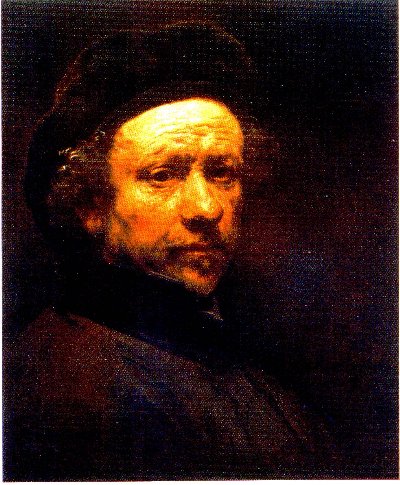| It has been over three centuries since Rembrandt’s self
portraits have been brought together for a single viewing. The last time they were seen
together was in his studio in Amsterdam, Holland during the seventeenth century. The
National Gallery of Art in London, England recently showed sixty of the self-portraits,
including two recent discoveries, in an exhibit titled Rembrandt By Himself. The
work spans his entire career, from the tousle-haired twenty-two year old of the
self-portrait from the Ritjksmuseum, Amsterdam, to the National Gallery’s own
self-portrait at the age of sixty-three, painted in 1669, the year of his death. The
self-portraits have been brought together from collections across Europe and America.
Lenders include the Royal Collection, the Rijksmuseum and Rembrandthuis in Amsterdam, the
National Gallery of Art in Washington, the Alte Pinakothek in Munich, and the
Kunsthistorisches Museum in Vienna. The National Gallery, London, and the Mauritshuis in
The Hague jointly organized the exhibition. |

Self Portrait with
Beret and Turned-Up Collar
Rembrandt Oil |
| Rembrandt by Himself,
is a breathtaking exhibition, and is one of the finest shows ever curated involving
Rembrandt’s work. The opportunity to view one masterpiece after another is a once in
a life time experience. At the beginning of the
exhibit, there are two works that clearly show Rembrandt’s virtuosity as a young
artist. They are two very compelling and strikingly similar self-portraits that he painted
in his early twenties. Both are painted in Rembrandt’s characteristic style, with
dramatic lighting illuminating the right side of the faces. This is a reoccurring quality
throughout his career. The space that they are situated in is very shallow, with a solid
grayish, green background. One tends to question this space. Is it solid, or is it an area
with no boundaries? Nevertheless, this sense of ambiguity adds to the mystery of the
pieces. He is very clever at sensitively diffusing the edges of forms, such as merging the
backgrounds and heads together, which make the portraits appear so convincingly natural.
In studying these works more closely, it is evident that he scraped actual hair follicles
into the wet paint surface, exposing the bright sienna ground. This technique is used in
many of the works in the show, adding to their animated quality.
When it comes to painting eyes, Rembrandt is a master
– the eyes in these portraits are set deep into the shadow sides, mysteriously with
no highlights. |
Strangely enough, the
expressions on the faces are ones of inquisitiveness. One of the more striking and thought provoking paintings in the show is Self-portrait
as Zeuxis, completed in 1662. This is one of many works in which Rembrandt portrays
himself as a character from history in costume.
"When it comes
to painting eyes, Rembrandt is the Master"
This type of painting was called a trony, which is a
painting of a character type, rather than strictly a self-portrait. This trony, unlike
others, has a tragic comic expression. There is an anecdote where Zeuxsis, a fifth century
artist, supposedly died of suffocation from laughter, due to making a portrait of an ugly
women. The character that Rembrandt depicted himself as seems to want to communicate with
the viewer. The signs of ala-prima brushwork is seen under the layers of glazed colors,
adding to the expression and movement of the portrait.
One of the most naturalistic pieces in the show is Self-portrait
with Beret and Turned-Up Collar, painted in 1659. Out of all the later portraits, |
this one appears most intro-
spective. There is a sense of solemnness. The background is a solid dark space,
setting-off the golden light that bathes the entire face. The viewer is lead to questions
Rembrandt’s thoughts. Is the expression representative of a confident artist, or one
approaching bankruptcy? (As he did later in life due to personal loss). Rembrandt by Himself, overall, is a visual masterpiece. His
ability to achieve emotions through paint, from the youthful, carefree attitude, to an old
age appearance of deep introspection and contemplation, is remarkable. It is obvious that
he is an ingenious draftsman and can represent through paint the natural texture of flesh,
fabric, fur, hair, jewelry, or even the sheen of armor. Many portraits appear so natural
that one can almost sense the temperature and odor of the subject. He manipulates the
paint surface like no artist before, achieving the ideal balance between the bravura of
expressive brushstrokes and the sensitive attention to minute detail. The mere painting of
an eye socket is a masterpiece in itself – in its multitude of painterly subtleties
– and the manner in which light emanates outward from it. An eye in a socket
interplays with the surrounding space, just as a head merges with the background.
Rembrandt undoubtedly remains one of the most gifted artists of all time. If you do find
the opportunity to view an exhibition of his work, take the time to – it is a once in
a lifetime experience!
RETURN TO
ARTICLES PAGE |